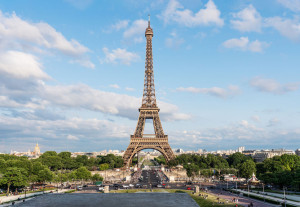 If you’ve ever traveled to Paris, chances are good you’ve visited the Eiffel Tower. The Eiffel Tower is still an impressive feat of engineering, even more than 130 years after its inauguration. But what you might not know about this landmark is that it became famous even before its opening.
If you’ve ever traveled to Paris, chances are good you’ve visited the Eiffel Tower. The Eiffel Tower is still an impressive feat of engineering, even more than 130 years after its inauguration. But what you might not know about this landmark is that it became famous even before its opening.
Erected in 1889 on Champs de Mars in Paris for the Fourth World Exposition, this technical advancement became synonymous with the city of Paris, France at large, and what can happen when humans dream bigger than they have before. People, for centuries, had attempted to build structures taller than the Great Pyramid in Giza. It was thought impossible until the Eiffel Tower stood twice as tall as these ancient ruins.
A first of its kind
Fast forward to today. It’s the most visited monument in the world. Yes, you read that right! More than six million people make the trek to the Parisian park to see this amazing structure in all its glory. As a result, the tower, the subject of much debate and discussion during its planning and construction, is now among the world’s most prominent monuments.
You might ask yourself why this tower is so popular. While it is easy to understand its appeal, it’s perhaps more challenging to explain its modern appeal due to its novelty alone. Since its completion, we have erected structures that are larger in size and scope as a global society. Many experts will tell you that it’s more than the sum of its parts. In addition to its architectural prowess, the Eiffel Tower represents a masterpiece of imagination of human effort.
An engineering marvel
Let’s dive deeper. Eiffel’s design office required more than 5,000 drawings for the tower and its 18,038 elements. Builders used more than 7,000 tons of wrought iron connected by 2.5 million rivets.
Consider the complexities associated with horse-drawn carts transporting pre-assembled parts of the structure from the company workshop near Paris to the site. More than 100 workers came on the site to offer technical support, and another 300 in the workshop had a hand in fabrication and erection.
The construction started on January 28, 1887, and was completed in only two years on March 31, 1889. At its debut, the tower clocked in at 300.65 meters (986 feet). The tower’s base is square, 125 meters (410 feet) per side. In 1957, an antenna was added, bringing the total height to 320.75 meters (1,052 feet). In 2000, the tower’s height reached 324 meters (1,063 feet) upon the installation of another antenna.
A symbolic and practical structure
But beyond being an aesthetic force, it seems Gustave Eiffel was well aware of the implications of his architectural contributions.
“It would symbolize not only the art of the modern engineer, but also the century of Industry and Science in which we are living, and for which the way was prepared by the great scientific movement of the eighteenth century and by the Revolution of 1789, to which this monument will be built as an expression of France’s gratitude,” Eiffel said.
Eiffel also took a pragmatic view of this project, encouraging multiple uses of the tower beyond mere entertainment. For instance, he was personally interested in using it to study wind forces and velocity as well as meteorological observations. On a related note, there’s no danger of the tower being damaged by high winds since it’s designed to withstand movements easily five times beyond those produced by the highest winds documented. Today, the movements are monitored by a system.
Another fact: The tower leans very slightly in bright sunlight, as one side is heated by the sun and expands slightly. Over the years, the tower has been used for transmitting radio signals and used more recently for television broadcasting.
More than a century later, the Eiffel Tower still takes our breath away. Why? The design in and of itself captivates the human spirit. Its elegant and slender form simultaneously evokes a feeling of strength and stability, almost a contradiction. This combination is a characteristic of the few truly great structures in the world, and the Eiffel Tower definitely warrants a spot at the top of this special list. As it straddles the past, present and future, we as structural engineers continue to be inspired by its magnitude.
Structural engineering is our bread and butter at McNeil Engineering. We may be biased but we believe the roles of structural engineering and structural engineers cannot be overstated in the 21st century. Ultimately, structural engineers help ensure that all the buildings and structures we see around are safe to use. Whether constructing a world-famous monument like the Eiffel Tower or a government building, safety is always at the front and center of our profession.
Feel free to reach out to us here for more information. We look forward to working with you on your next project. (801) 225-7700








